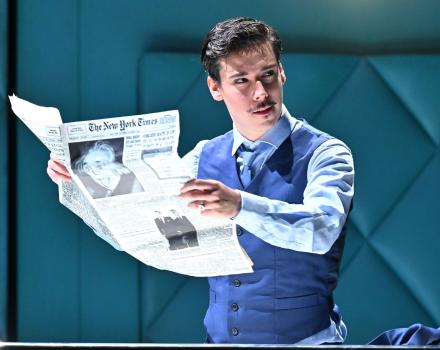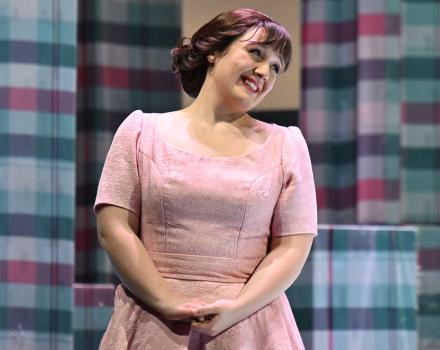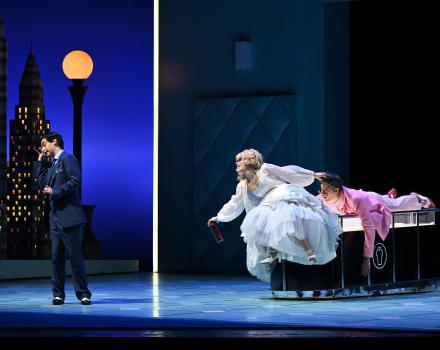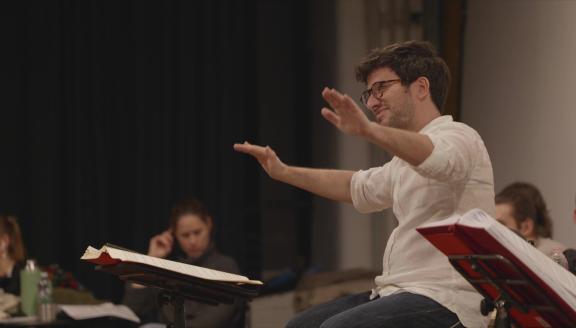
Geronimo is a man of standing with a business to run and two daughters, Elisetta and Carolina, to marry off. A little nostalgic for his native Italy, Geronimo runs a thriving cake boutique in 1950’s New York. Between an aristocratic customer and a humble delivery boy, will his daughters make the right choices in love?
Il matrimonio segreto, a dramma giocoso in two acts, is Domenico Cimarosa’s best-known opera. The first performance took place on 7 February 1792 at the Hofburgtheater in Vienna in the presence of Emperor Leopold II, who liked it so much that, after giving dinner to the whole company, he asked for a complete second performance - perhaps the longest encore in history. As with the best opera buffa of the 18th-century, it contains a plot full of impossible situations (might just one of the daughters be married already?), elaborate disguises and, of course, a happy ending. Elements of the music are unmistakably Mozartian but others anticipate Rossini, such as the patter of fast words sung on a repeated note and some comic nonsense sounds. In every way, Il matrimonio segreto is ideally suited to a young talented cast, which Teatro Regio di Parma has assembled for this new production made in collaboration with the Auditorio de Tenerife and Teatro Massimo of Palermo.
Cast
|
Carolina
|
Giulia Mazzola
|
|---|---|
|
Paolino
|
Antonio Mandrillo
|
|
Fidalma
|
Veta Pilipenko
|
|
Geronimo
|
Francesco Leone
|
|
Elisetta
|
Marilena Ruta
|
|
Conte Robinson
|
Jan Antem
|
|
Orchestra
|
Orchestra Cupiditas
|
| ... | |
|
Music
|
Domenico Cimarosa
|
|---|---|
|
Text
|
Giovanni Bertati
Franco Donatoni
|
|
Conductor
|
Davide Levi
|
|
Director
|
Roberto Catalano
|
|
Sets
|
Emanuele Sinisi
|
|
Costumes
|
Ilaria Ariemme
|
|
Lighting
|
Fiammetta Baldiserri
|
|
Choreographer
|
Sandhya Nagaraja
|
| ... | |
New staging by Teatro Regio di Parma. Co-production with Ópera de Tenerife and Teatro Massimo di Palermo.
Videos
STORY
Act 1
Carolina, the daughter of the rich merchant Geronimo, secretly married Paolino, the accountant of Geronimo's shop. Paolino has a solution: since Geronimo intends to marry both his daughters Carolina and Elisetta to a nobleman, Paolino manages to make Elisetta marry Count Robinson, obtaining a substantial dowry for the girl which, he hopes, he could use to obtain a credit of trust when he reveals the secret (introduction: “Cara, non dubitar”). The two leave before being discovered together (duet: “Io ti lascio perché uniti”). Count Robinson writes a letter to Geronimo in which he agrees to marry Elisetta soon. Since Geronimo, seeing his social ambitions taking shape, is now set on finding a noble match for Carolina. (cavatina: “Udite tutti, udite”). In the meantime, he prepares to welcome the Count by alerting the whole family, but he mistakenly takes Carolina's frown as a sign of envy towards her older sister who, in turn, interprets it as lack of respect: the two end up quarreling and Fidalma tries to defend Elisetta (trio: “Le fatto un inchino”).
Once Carolina leaves, Fidalma tells Elisetta that she intends to get married, though she does not want to reveal the man she has already chosen (aria: “È vero che in casa”). Count Robinson arrives in a pompous fashion and, seeing Carolina, believes she will be her future wife, unable to hide his disappointment when he discovers that his wife will be Elisetta (cavatina: "Senza senza cerimonie"). Everyone immediately understands that the situation could bring trouble (quartet: "Sento in petto un freddo gelo"). Carolina warns Paolino of her father's intentions to marry her and urges him to reveal her secret marriage. Paolino has faith in the support of Count Robinson, or at least in that of Fidalma who, he says, treats him with great affection. But Paolino does not have time to explain everything to the Count, who reveals that he wants to marry Carolina instead of Elisetta for half of the promised dowry for Elisetta (duet: “Signor, deh, concedete”).
Carolina sees the Count arrive. She is convinced that the conversation with Paolino is over, but the desire to speak with him creates a misunderstanding. When she learns that the Count does not want to know about Elisetta but is in love with her instead, she tries to escape by arguing that she is not cultured or refined enough to marry a nobleman (aria: “Perdonate, signor mio”). Left alone, the Count suspects that Carolina has a lover. In the meantime, Elisetta, supported by her aunt, complains to her father about the Count's behaviour (first ending: “Tu mi dici che del Conte”). Carolina arrives chased by the Count, who tries to find out if there is another man in her life and underlines his indifference towards Elisetta. In turn, Elisetta (hidden) has heard everything about her and accuses her sister, who tries in vain to explain herself. All that noise first attracts Fidalma, who adds to even more confusion, and then Geronimo (who often misunderstands his words, being almost deaf). Eventually, the Count explains that he is in love with Carolina and not with Elisetta, causing amazement and much chattering.
Act 2
Geronimo calls for the Count to ask him about the recent events. After confessing his lack of interest in Elisetta and his attraction towards Carolina, the Count proposes halving the dowry, a great solution for Geronimo. The two agree instantly on condition that Elisetta agrees (duet “Se fiato in corpo hai”). Arriving shortly after, Paolino hears from the Count himself the news of the agreement and understands that it is necessary to play the last card in his hand to solve the situation: the mediation by Fidalma, who arrives at that very moment. However, there is once again the misunderstanding: Fidalma mistakes Paolino's embarrassment for a sign of love and she reveals that she wants to marry him. Paolino faints. At that moment, Carolina arrives alarmed. Fidalma reveals her intentions to her, convinced that Paolino is also consenting (trio: “Sento, oimé, che mi vien male”). Left alone with him, Carolina is indignant at the situation until Paolino explains to her what happened, admitting that by now all plans have failed and confessing that there is only one solution left: fleeing together and leaving Geronimo to deal with it (aria: “Prima che spunti in ciel l'aurora”). Nevertheless, Carolina does not like the idea of creating a scandal and upsetting her father.
The Count runs into Elisetta and tries to make her give up on her marriage by listing his own flaws, to the point of confessing that he does not love her (aria: "Son lunatico bilioso"). Elisetta is now disturbed and, once the Count has left, she clearly tells Fidalma that it is necessary to take Carolina out of her house. In turn, Fidalma admits that she suspects that Carolina is in love with Paolino, which annoys her greatly. The two inform Geronimo that the cause of the problem must be eliminated: Carolina must be sent away (trio: “Cosa farete? via, su, parlate”). Geronimo is reluctant to give up the Count's proposal but, fearing that his sister Fidalma would withdraw her capital from the business, he accepts the proposal and communicates it to Carolina.
Carolina is in despair (accompanied recitative: “Come tacerlo poi, se in un retiro”). The Count finds her in such a state and immediately tries to console her, declaring himself ready to fulfill her every wish and kissing her hand. He is suddenly surprised by Fidalma, Elisetta and Geronimo, who now believe they have proof of the relationship between Carolina and the Count. With great excitement, the Count is unable to explain his version (quintet: “Deh, ferme ch’io respiri”). But Geronimo is firm: Carolina's departure is decided. Fidalma and Elisetta are now left alone and continue to spread infamy over Carolina (aria: “Se son vendicata”).
Geronimo gives Paolino a letter for the superintendent of the retreat he wants to send Carolina to, entrusting him with all the preparations. He then goes to sleep. Paolino sees it as the last chance to act and to run away with Carolina. The two are about to leave Carolina's room when they hear someone (ending: “Deh, ti comforta, o cara”). The two go back to the room. Elisetta sees the Count walking around. In turn, the Count is in distress as he would like to know what is troubling Carolina's heart (aria: Il parlar di Carolina”). Convinced that the Count is with Carolina, Elisetta alerts Fidalma and her father. Irritated, the Count leaves the room, but not with Carolina. Everyone calls for the girl who, in the end, is forced to leave the room with Paolino: the two kneel down, asking for forgiveness and confessing their secret marriage. Geronimo is furious. Finally, the Count intervenes: what is done cannot be changed and, out of love for Carolina, he prefers to see her happy together with Paolino and he agrees to marry Elisetta. Geronimo can now calm down. He forgives them and everyone celebrates.
INSIGHTS
Davide Levi on Il matrimonio segreto - the conductor’s viewpoint
On 5 December 1791, Wolfgang Amadeus Mozart dies in Vienna. While returning to Italy from Russia, Domenico Cimarosa arrives in Vienna in that same period and, on 7 February 1792, Il matrimonio segreto premieres to great success at the Burgtheater. In such circumstances, it is hard not to compare the two composers, and there are certain similarities between Nozze di Figaro or Magic Flute and Il matrimonio segreto. And you would not be mistaken, if you heard some Rossini there too…
Nevertheless, there are elements in Il matrimonio segreto which set Cimarosa apart, in particular, his ability to create and integrate melodies of extraordinary beauty. Every aria, every duet, trio, quartet, quintet contains melodies and counter-melodies of great inventiveness. And this is not only true of the vocal lines. Take the duet at the beginning of Act II (a source of inspiration for Rossini, without a doubt), when Geronimo reflects upon the proposal of Count Robinson to marry Carolina, instead of Elisetta. While the rich merchant thinks and mumbles ‘Qua risparmio del bell’oro/qua si salva anche il decoro’, the first violins send up a melody from the pit, as if accompanying his thought-process, adding a touch of parody.
These melodies are the most beautiful that have been given to the human soul to conceive.
Some would say that Cimarosa’s orchestral writing in Il matrimonio segreto does not appear to fully employ the multi-chromatic palette of timbres from the entire orchestra. The flutes, for instance, are ‘forgotten’ after the aria by Fidalma in the first act and there is almost constant doubling of violas, cellos, contrabasses and bassoons. The vocal parts, however, which require highly-skilled singers in terms of both acting and interpretation, give birth to an intense, varied and very funny opera. On stage, Cimarosa creates his little magic where, through a few arias, many choral moments, and the intertwinings of elements of the libretto, we are launched into a joyful, exciting world of the best opera buffa of the Neapolitan school.
The comedy on the stage, the elegance in the music, the creativity of the plot, the energy that fills the opera note by note - all these elements to me account for Il matrimonio segreto’s success in 1792 and throughout the whole of the following century.
Gallery



















